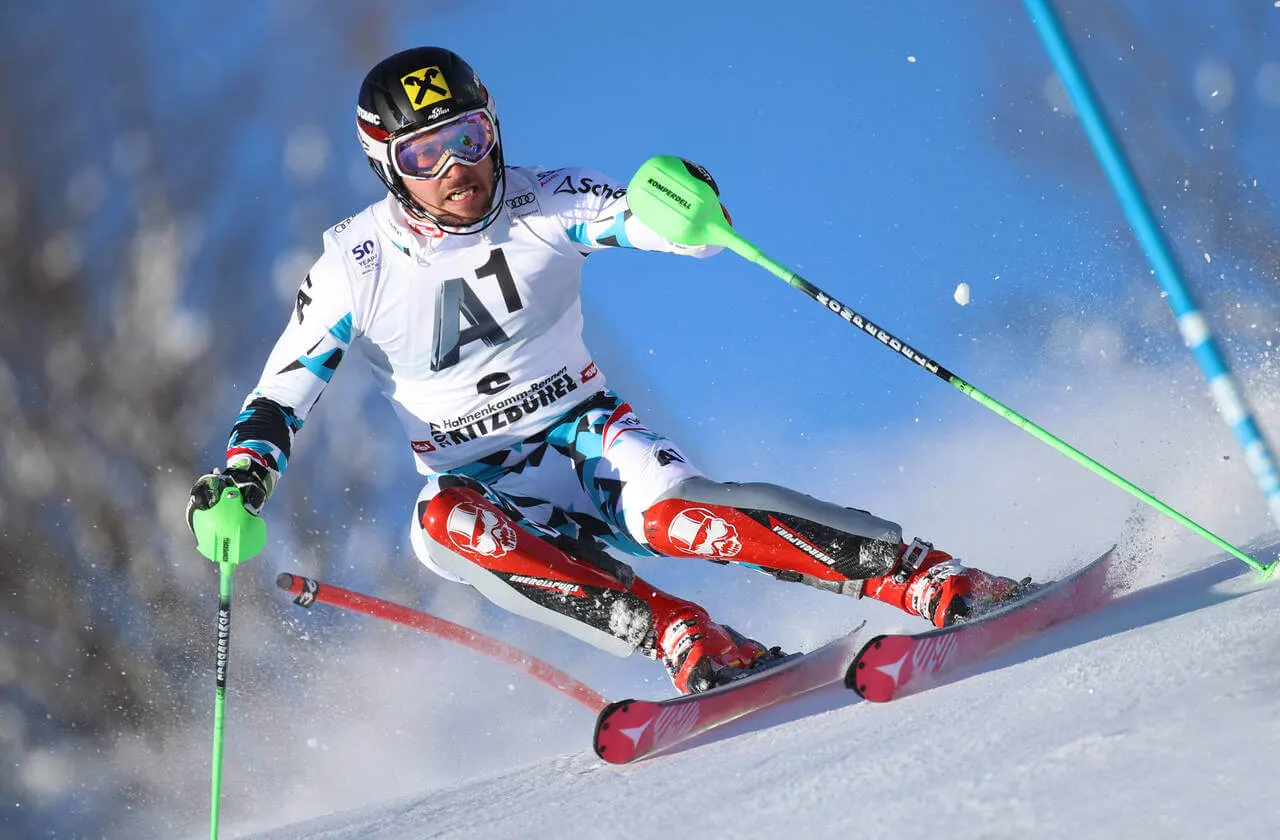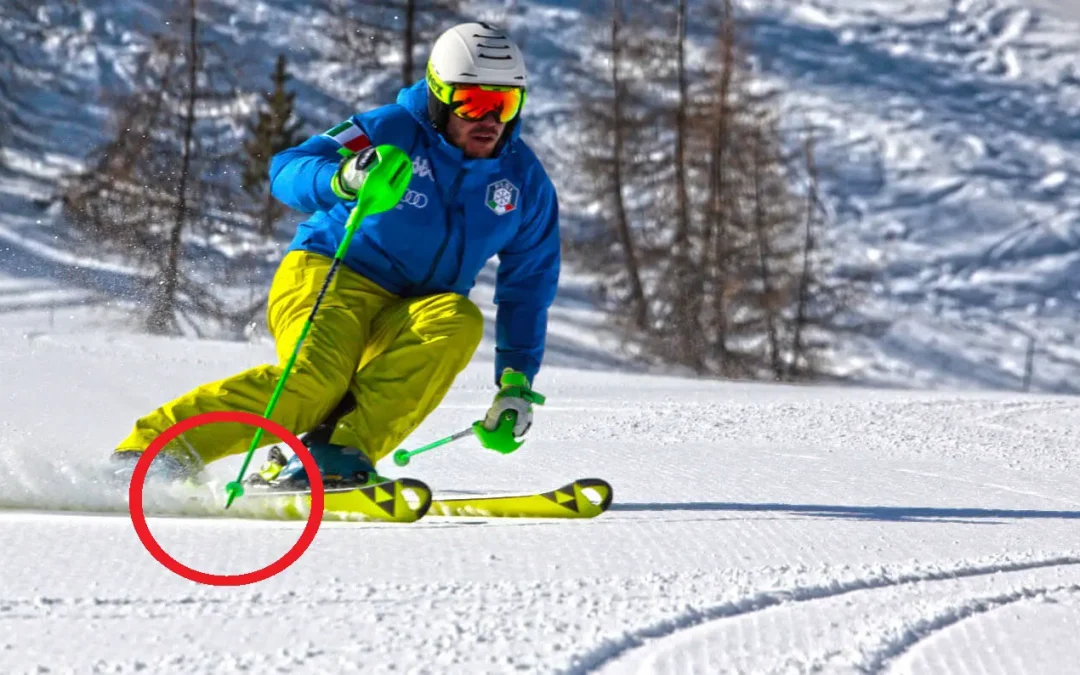In this blog we encourage, as the great Ron LeMaster used to say, skiing “from the snow up”: the most important movements are with the feet and legs first, and then the rest of the body. But once the skier has good foot/leg work, and their parallel turns are becoming increasingly dynamic and rhythmic, it’s time to introduce the pole usage. And never stop using it. My advice is to practice until it becomes second nature and you no longer need to focus on doing it.
Briefly touching the snow with the pole on the same side of the upcoming turn is very useful anywhere on the mountain, but crucial when skiing short turns, steeps, bumps, or powder. A good pole plant will make your turns both easier and better.
Hands position while skiing
While skiing down the mountain we should be always looking ahead, of course, and our hands should be just inside our field of vision. In other words, we have to see our hands in our peripheral vision. That’s a quite good indication of correct hand position. They shouldn’t be that far ahead, but definitely never down beside our bodies.
Pole plant action
The pole action has two main parts:
1) The pole Swing
2) The actual pole Plant or Touch
The pole swing is done by a small flexing of the forearm and wrist, with the goal of advancing the pole tip forward. This pole swing can happen all at once just before planting it, or can start when we start the turn and last the same time it takes to perform the turn. That is, the pole swings forward at the same rate or progression as you are through the turn, and definitely makes it look like a very fluid and more coordinated skiing. I personally prefer this way over the other.
The pole plant is done predominantly by a “flick of the wrist action”, and little to no lower arm motion. Arms position should always be in front (never arm swinging), but relaxed.
Actually, the pole plant is more of a pole “touch” than sticking the pole in the snow. Pole planting doesn’t need to be over-exaggerated to be effective. A pole plant can be everything from the lightest touch in high-speed GS turns to much more pronounced punches in bumps and steeps. But the pole action is there in almost all cases. It remains a fundamental part of solid ski technique.
Both pole swing and pole touch should be made with the pole inclined in the same amount as the legs, in the turn. So the outside pole should look always parallel to the lower body.

In the image above, you can see that the pole inclination angle is similar to that of the legs.
The pole swing can happen all at once just before planting it, or can start when we start the turn and last the same time it takes to perform the turn. That is, the pole swings forward at the same rate or progression as we are through the turn, and definitely makes it look as a very fluid and more coordinated skiing. I personally prefer this way over the other.
Pole plant usage
- Propulsion or pushing ourselves around on flats (poling)
- Balance: it is important to remember that the pole plant is merely an aid to balance. It does not mean that we should support ourselves on the pole itself. We don’t put any weight onto the pole, the pole is just another sensor for us, regarding terrain shape and/or steepness.
- Adds control to our skiing
- Timing of the turns: the pole plant dictates the start of a new turn to that side.
- Rhythm and flow: the pole plant really helps to link the turns together. The pole plant is a timing device to keep a constant rhythm.
- Helps stabilize the upper body
- Helps move forward for the upcoming turn (re-centering)
- Helps move across the skis in transition
- Perform various ski drills
- To avoid running into people in the narrow lift lines (as a brake)
And don’t forget that one of the most important uses of poles is tapping them together immediately before you push off for a killer run. Tapping your poles clicks your mind into very focused committed skier mode.
Pole plant timing
It is important to associate the pole plant with the end of the existing turn, not with the start of a new turn. By getting into the mindset of planting early at the end of the turn, we get all the benefits of it.
We have to place the pole into the snow when we start to decrease the edge angle of the turn we are finishing (that is before edge change).
I like to think of the pole plant as kind of the first movement to prepare to for a new turn, but it actually occurs at the end of the previous turn. That’s the most efficient way.
We could think of the pole plant as a signal to start to move our body weight to the new turn.

Marcel Hirscher at 2017 Kitzbühel (AUS) Slalom pole planting way before edge change

Alice Robinson pole planting at 2022 Kranjska Gora (SLO) Giant Slalom

Pole plant placement
As a general rule, the pole is planted on an area towards the front of the ski (between the binding and the ski tip). But in short turns and in the steeps, the pole will be planted in a direction more towards the valley (straight downhill). Take a look at the image bellow.

Keep ripping some arcs!
If you find this piece of information useful to improve your skiing, please support this website and help us to keep it up and create more content! A small donation really means a lot to us... Thank you so much!


I just wanted to say props to who ever wrote this article. I envisioned every step as it was very descriptive.
Thanks a lot Rob. I really appreciatte feedback. Cheers!
Would you agree that in bumps, the pole should be planted somewhat downhill of where most skiers target? I learned to plant at the crest of the bump, but it has recently been suggested to me that this is not ideal.
Thank you for your comment. Pole planting is critical to skiing bumps, as it will help with the rhythm of your turns and provide stability for the upper body. Regarding your question, I think that planting the pole on the back of the bump increases the overall speed of the skier, down the slope. So, it shouldn’t be encouraged unless you are an expert skier.
That being said, sometimes a strong plant on the crest is hard on the shoulder of the skier, because it tends to snap back aggresively. That is why it is recommended to use shorter poles in bump skiing, actually.
What is usually encouraged is to plant your poles just below the crest of the mogul, on the front side of the bump. Cheers from Argentina!!!